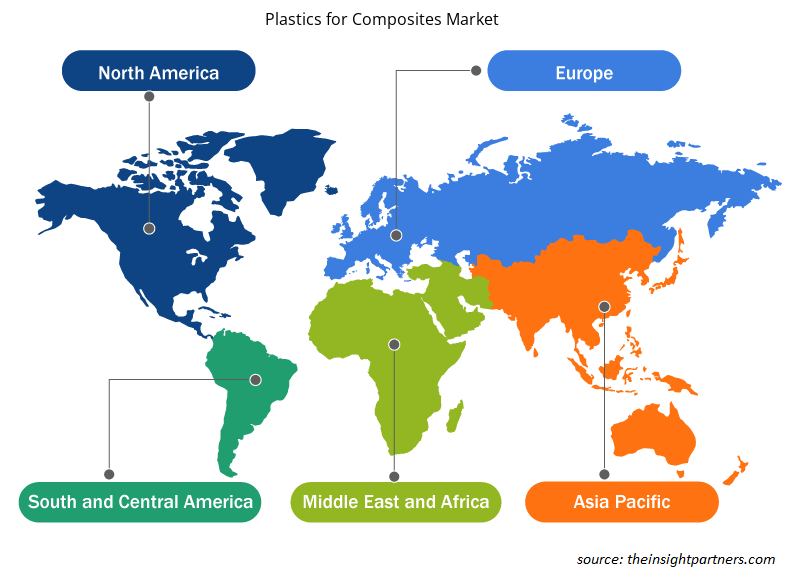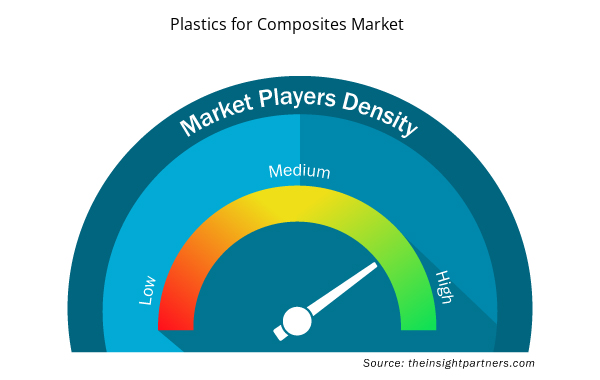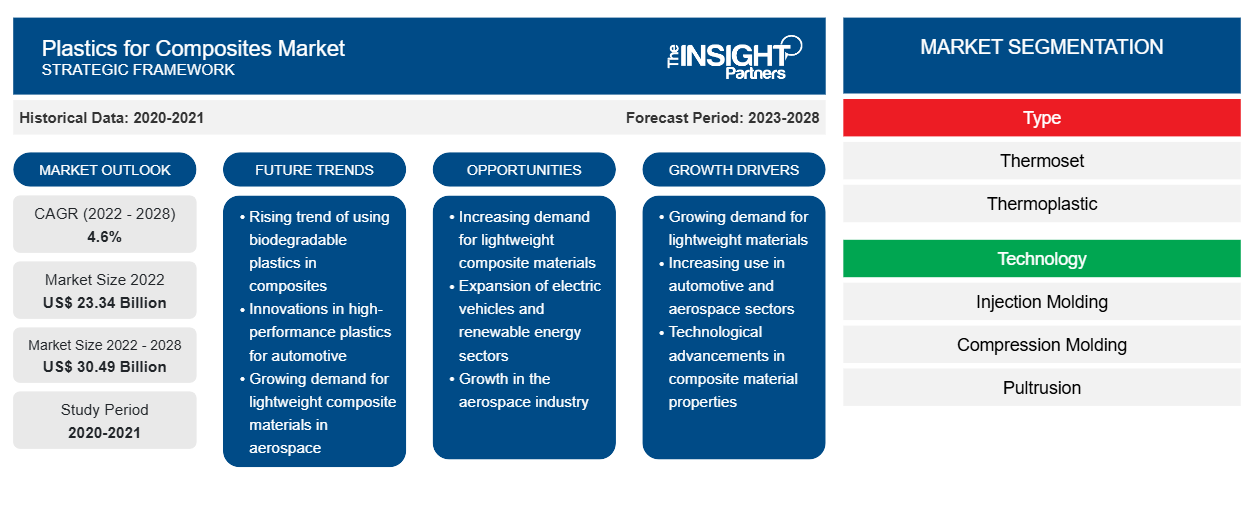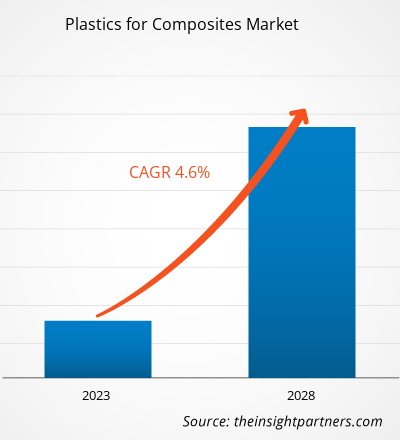Si prevede che il mercato delle materie plastiche per compositi crescerà da 23.337,24 milioni di dollari nel 2022 a 30.490,85 milioni di dollari entro il 2028; si stima che registrerà un CAGR del 4,6% dal 2022 al 2028.CAGR of 4.6% from 2022 to 2028.
I compositi sono materiali costituiti da due o più fasi chimicamente e fisicamente diverse, separate da un'interfaccia distinta. La maggior parte dei compositi prodotti commercialmente utilizza un materiale a matrice polimerica, spesso chiamato soluzione di resina. Le matrici polimeriche comunemente utilizzate includono poliestere, vinilestere, epossidico, fenolico, poliimmide, poliammide, polipropilene e polietere etere chetone (PEEK). Basso costo, facile lavorabilità, buona resistenza chimica e bassa gravità specifica sono tra i principali vantaggi associati alle matrici polimeriche.
La crescente adozione di resine composite nelle attività di edilizia e costruzione e nelle applicazioni aerospaziali e militari sta contribuendo alla crescita del mercato delle materie plastiche per compositi . Inoltre, la domanda di materiali leggeri nella produzione di veicoli, per migliorare l'efficienza del carburante, è un altro fattore che spinge l'espansione del mercato. Inoltre, la crescente domanda di resine termoplastiche sta contribuendo in modo significativo alla crescita complessiva del mercato delle materie plastiche per compositi. Fibre rigide e maggiore resistenza al calore, resistenza alle crepe, elevata resistenza agli urti e matrice polimerica resistente sono le principali caratteristiche dei compositi polimerici che ne determinano la popolarità. È probabile che i crescenti investimenti nella generazione di energia rinnovabile inneschino la domanda di compositi polimerici nei prossimi anni.
Personalizza questo report in base alle tue esigenze
Riceverai la personalizzazione gratuita di qualsiasi report, comprese parti di questo report, o analisi a livello nazionale, pacchetto dati Excel, oltre a usufruire di grandi offerte e sconti per start-up e università
- Scopri le principali tendenze di mercato in questo rapporto.Questo campione GRATUITO includerà analisi di dati che spaziano dalle tendenze di mercato alle stime e alle previsioni.
Approfondimenti di mercato
La crescente domanda da parte dei settori automobilistico e aerospaziale stimola la crescita del mercato delle materie plastiche per compositi
La resina composita è utilizzata in varie applicazioni, tra cui edilizia e infrastrutture, trasporti, elettricità ed elettronica, energia eolica, condotte e serbatoi, marina, aerospaziale e militare. I materiali avanzati sono fondamentali per aumentare il risparmio di carburante delle automobili moderne, garantendo al contempo sicurezza e prestazioni. Poiché ci vuole meno energia per accelerare oggetti più leggeri rispetto a quelli più pesanti, i materiali leggeri offrono un potenziale eccellente per aumentare l'efficienza del veicolo. Pertanto, l'elevata domanda di compositi da parte dell'industria automobilistica per la produzione di veicoli leggeri ed efficienti nei consumi guida la crescita del mercato delle materie plastiche per compositi. Le industrie di utilizzo finale nelle economie emergenti, come Cina e India, sono i principali fattori che contribuiscono alla crescente domanda di materie plastiche per compositi. La crescente necessità di materiali più leggeri per costruire componenti e parti aeronautiche è stato un altro fattore significativo che ha contribuito alla crescita del mercato delle materie plastiche per compositi. I produttori di aeromobili stanno compiendo sforzi per ingrandire le strutture termoplastiche primarie nei jet aziendali e negli aerei commerciali. Sono stati i primi ad adottare termoplastiche rinforzate con fibre lunghe.
Tipo Informazioni
In base al tipo, il mercato delle materie plastiche per compositi è suddiviso in termoindurenti (poliestere, vinilestere, epossidico, poliuretano e altri) e termoplastici (polipropilene, polietilene, cloruro di polivinile, polistirene, polietilene tereftalato, policarbonato e altri). Il segmento dei termoindurenti ha detenuto una quota maggiore del mercato nel 2021. I termoindurenti sono un popolare materiale a matrice polimerica per compositi rinforzati con fibre. Esempi comuni di termoindurenti includono epossidici e poliesteri. Sono tra i principali tipi di sistemi a matrice, utilizzati specificamente nell'industria aerospaziale. I compositi a matrice termoindurente sono utilizzati più ampiamente rispetto ai compositi a matrice termoplastica a causa della loro minore viscosità a temperature relativamente basse (inferiori a 100 °C), che facilita meglio il processo di bagnatura resina/fibra. Si prevede che questi fattori guideranno la crescita del mercato dei componenti a matrice termoindurente.thermoset (polyester, vinyl ester, epoxy, polyurethane, and others) and thermoplastic (polypropylene, polyethylene, polyvinyl chloride, polystyrene, polyethylene terephthalate, polycarbonate, and others). The thermoset segment held a larger share of the market in 2021. Thermoset is a popular polymer matrix material for fiber-reinforced composites. Common examples of thermosets include epoxies and polyesters. They are among the major types of matrix systems, specifically used in the aerospace industry. Thermoset matrix composites are more extensively used than thermoplastic matrix composites due to their lower viscosity at relatively low temperatures (less than 100°C), which better facilitates the resin/fiber wetting process. These factors are expected to drive the growth of the market for thermoset matrix
Lanxess AG, Covestro AG, Celanese Corp, INEOS Group Holdings SA, Daicel Corp, BASF SE, Evonik Industries AG, Solvay SA, Saudi Basic Industries Corp e Arkema SA sono tra i principali attori che operano nel mercato delle materie plastiche per compositi. I principali attori adottano strategie come fusioni e acquisizioni e lanci di prodotti per espandere la loro presenza geografica e la base di consumatori. Ad esempio, a giugno 2022, Lanxess AG ha lanciato un composito con matrice in poliammide 6 basato su cicloesano "verde".
Approfondimenti regionali sul mercato delle materie plastiche per compositi
Le tendenze regionali e i fattori che influenzano il mercato delle materie plastiche per compositi durante il periodo di previsione sono stati ampiamente spiegati dagli analisti di Insight Partners. Questa sezione discute anche i segmenti e la geografia del mercato delle materie plastiche per compositi in Nord America, Europa, Asia Pacifico, Medio Oriente e Africa e America meridionale e centrale.

- Ottieni i dati specifici regionali per il mercato delle materie plastiche per compositi
Ambito del rapporto di mercato sulle materie plastiche per compositi
| Attributo del report | Dettagli |
|---|---|
| Dimensioni del mercato nel 2022 | 23,34 miliardi di dollari USA |
| Dimensioni del mercato entro il 2028 | 30,49 miliardi di dollari USA |
| CAGR globale (2022 - 2028) | 4,6% |
| Dati storici | 2020-2021 |
| Periodo di previsione | 2023-2028 |
| Segmenti coperti | Per tipo
|
| Regioni e Paesi coperti | America del Nord
|
| Leader di mercato e profili aziendali chiave |
|
Densità degli attori del mercato delle materie plastiche per compositi: comprendere il suo impatto sulle dinamiche aziendali
Il mercato delle materie plastiche per compositi sta crescendo rapidamente, spinto dalla crescente domanda degli utenti finali dovuta a fattori quali l'evoluzione delle preferenze dei consumatori, i progressi tecnologici e una maggiore consapevolezza dei vantaggi del prodotto. Con l'aumento della domanda, le aziende stanno ampliando le loro offerte, innovando per soddisfare le esigenze dei consumatori e capitalizzando sulle tendenze emergenti, il che alimenta ulteriormente la crescita del mercato.
La densità degli operatori di mercato si riferisce alla distribuzione di aziende o società che operano in un particolare mercato o settore. Indica quanti concorrenti (operatori di mercato) sono presenti in un dato spazio di mercato in relazione alle sue dimensioni o al valore di mercato totale.
Le principali aziende che operano nel mercato delle materie plastiche per compositi sono:
- Lanxess AG
- Covestro AG
- Celanese Corp
- Società del Gruppo INEOS SA
- Daicel Corp
Disclaimer : le aziende elencate sopra non sono classificate secondo un ordine particolare.

- Ottieni una panoramica dei principali attori del mercato delle materie plastiche per compositi
Segnala i riflettori
- Tendenze progressive nel settore delle materie plastiche per compositi per aiutare gli operatori a sviluppare strategie efficaci a lungo termine
- Strategie di crescita aziendale adottate dalle aziende per garantire la crescita nei mercati sviluppati e in via di sviluppo
- Analisi quantitativa del mercato globale delle materie plastiche per compositi dal 2020 al 2028
- Stima della domanda di materie plastiche per compositi in vari settori industriali
- Analisi delle cinque forze di Porter per illustrare l'efficacia degli acquirenti e dei fornitori che operano nel settore delle materie plastiche per i compositi
- Sviluppi recenti per comprendere lo scenario competitivo del mercato e la domanda di materie plastiche per compositi
- Tendenze e prospettive di mercato e fattori che regolano la crescita del mercato delle materie plastiche per compositi
- Strategie illuminanti che sostengono l'interesse commerciale in merito alla crescita del mercato, aiutando nel processo decisionale
- Dimensioni del mercato delle materie plastiche per compositi in vari nodi di mercato
- Panoramica dettagliata e segmentazione del mercato, nonché dinamiche del settore
- Dimensioni del mercato delle materie plastiche per compositi in varie regioni con promettenti opportunità di crescita
"Plastics for Composites Market Analysis to 2028" è uno studio specializzato e approfondito del settore chimico e dei materiali, incentrato sull'analisi delle tendenze del mercato delle plastiche per compositi. Il rapporto mira a fornire una panoramica del mercato con una segmentazione dettagliata. Il mercato delle plastiche per compositi è segmentato in base a tipo, tecnologia e geografia. In base al tipo, il mercato è segmentato in termoindurenti (poliestere, vinilestere, epossidico, poliuretano e altri) e termoplastici (polipropilene, polietilene, cloruro di polivinile, polistirene, polietilene tereftalato, policarbonato e altri). In base alla tecnologia, il mercato è segmentato in stampaggio a iniezione, stampaggio a compressione, pultrusione, infusione di resina e altri. In termini di geografia, il mercato è segmentato in cinque regioni principali: Nord America, Europa, Asia Pacifico, Medio Oriente e Africa e Sud e Centro America. Nel 2021, l'Asia Pacifico ha dominato il mercato delle plastiche per compositi. Si prevede che la regione registrerà il CAGR più elevato nel mercato durante il periodo di previsione. I settori automobilistico e delle costruzioni nell'Asia Pacifica stanno crescendo a un ritmo rapido. È la regione più popolata al mondo e ospita uno dei settori delle costruzioni in più rapido sviluppo al mondo. Questi fattori contribuiscono a un'elevata domanda di materie plastiche per compositi nell'Asia Pacifica.
- Analisi storica (2 anni), anno base, previsione (7 anni) con CAGR
- Analisi PEST e SWOT
- Valore/volume delle dimensioni del mercato - Globale, regionale, nazionale
- Industria e panorama competitivo
- Set di dati Excel


- Photo Printing Market
- Identity Verification Market
- Small Satellite Market
- Maritime Analytics Market
- Legal Case Management Software Market
- Electronic Signature Software Market
- Virtual Event Software Market
- Webbing Market
- Personality Assessment Solution Market
- Integrated Platform Management System Market

Report Coverage
Revenue forecast, Company Analysis, Industry landscape, Growth factors, and Trends

Segment Covered
This text is related
to segments covered.

Regional Scope
North America, Europe, Asia Pacific, Middle East & Africa, South & Central America

Country Scope
This text is related
to country scope.
Domande frequenti
The increasing utilization of plastics for composites in building & construction activity, aerospace, and military applications are some of the key factors that contribute to the growth of the market. In addition, the demand for lightweight materials from transportation, which in response improves the efficiency of fuel, is another factor propelling the expansion of the market. These factors are driving the plastics for composites market growth.
During the forecast period, thermoplastic is expected to be the fastest-growing segment. The growing adoption of thermoplastic within the automotive industry, rising demand for recyclable and fast-curing materials, increasing demand for automobiles, and growing penetration of composite materials by replacing metals are significant factors boosting the growth of the thermoplastic segment in plastics for composites market demand during the forecast period.
During the forecast period, the compression molding segment is expected to be the fastest-growing segment. The manufacture of various parts of electronic and automotive products has increased due to the increased demand for automotive and electrical products, particularly vehicles, mobile phones and tablets. The compression molding process is primarily used in the fabrication of these parts. These factors are expected to accelerate the growth of the compression molding segment of the plastics for composites market.
In 2021, the thermoset segment held the largest market share. Increased use of thermoset plastic in the aerospace and automobile industry due to their lower viscosity at relatively low temperatures (less than 100°C), which better facilitates the resin/fiber wetting process led to the dominance of the thermoset segment in the plastics for composites market.
The major players operating in the plastics for composites market are Lanxess AG, Covestro AG, Celanese Corp, INEOS Group Holdings SA, Daicel Corp, BASF SE, Evonik Industries AG, Solvay SA, Saudi Basic Industries Corp, and Arkema SA.
In 2021, Asia-Pacific accounted for the largest share of the global plastics for composites market. Growing demand from construction, wind power, electronics, and automotive industries led to the dominance of the Asia Pacific region in 2021.
Trends and growth analysis reports related to Chemicals and Materials : READ MORE..
The List of Companies - Plastics for Composites Market
- Lanxess AG
- Covestro AG
- Celanese Corp
- INEOS Group Holdings SA
- Daicel Corp
- BASF SE
- Evonik Industries AG
- Solvay SA
- Saudi Basic Industries Corp
- Arkema SA
The Insight Partners performs research in 4 major stages: Data Collection & Secondary Research, Primary Research, Data Analysis and Data Triangulation & Final Review.
- Data Collection and Secondary Research:
As a market research and consulting firm operating from a decade, we have published and advised several client across the globe. First step for any study will start with an assessment of currently available data and insights from existing reports. Further, historical and current market information is collected from Investor Presentations, Annual Reports, SEC Filings, etc., and other information related to company’s performance and market positioning are gathered from Paid Databases (Factiva, Hoovers, and Reuters) and various other publications available in public domain.
Several associations trade associates, technical forums, institutes, societies and organization are accessed to gain technical as well as market related insights through their publications such as research papers, blogs and press releases related to the studies are referred to get cues about the market. Further, white papers, journals, magazines, and other news articles published in last 3 years are scrutinized and analyzed to understand the current market trends.
- Primary Research:
The primarily interview analysis comprise of data obtained from industry participants interview and answers to survey questions gathered by in-house primary team.
For primary research, interviews are conducted with industry experts/CEOs/Marketing Managers/VPs/Subject Matter Experts from both demand and supply side to get a 360-degree view of the market. The primary team conducts several interviews based on the complexity of the markets to understand the various market trends and dynamics which makes research more credible and precise.
A typical research interview fulfils the following functions:
- Provides first-hand information on the market size, market trends, growth trends, competitive landscape, and outlook
- Validates and strengthens in-house secondary research findings
- Develops the analysis team’s expertise and market understanding
Primary research involves email interactions and telephone interviews for each market, category, segment, and sub-segment across geographies. The participants who typically take part in such a process include, but are not limited to:
- Industry participants: VPs, business development managers, market intelligence managers and national sales managers
- Outside experts: Valuation experts, research analysts and key opinion leaders specializing in the electronics and semiconductor industry.
Below is the breakup of our primary respondents by company, designation, and region:

Once we receive the confirmation from primary research sources or primary respondents, we finalize the base year market estimation and forecast the data as per the macroeconomic and microeconomic factors assessed during data collection.
- Data Analysis:
Once data is validated through both secondary as well as primary respondents, we finalize the market estimations by hypothesis formulation and factor analysis at regional and country level.
- Macro-Economic Factor Analysis:
We analyse macroeconomic indicators such the gross domestic product (GDP), increase in the demand for goods and services across industries, technological advancement, regional economic growth, governmental policies, the influence of COVID-19, PEST analysis, and other aspects. This analysis aids in setting benchmarks for various nations/regions and approximating market splits. Additionally, the general trend of the aforementioned components aid in determining the market's development possibilities.
- Country Level Data:
Various factors that are especially aligned to the country are taken into account to determine the market size for a certain area and country, including the presence of vendors, such as headquarters and offices, the country's GDP, demand patterns, and industry growth. To comprehend the market dynamics for the nation, a number of growth variables, inhibitors, application areas, and current market trends are researched. The aforementioned elements aid in determining the country's overall market's growth potential.
- Company Profile:
The “Table of Contents” is formulated by listing and analyzing more than 25 - 30 companies operating in the market ecosystem across geographies. However, we profile only 10 companies as a standard practice in our syndicate reports. These 10 companies comprise leading, emerging, and regional players. Nonetheless, our analysis is not restricted to the 10 listed companies, we also analyze other companies present in the market to develop a holistic view and understand the prevailing trends. The “Company Profiles” section in the report covers key facts, business description, products & services, financial information, SWOT analysis, and key developments. The financial information presented is extracted from the annual reports and official documents of the publicly listed companies. Upon collecting the information for the sections of respective companies, we verify them via various primary sources and then compile the data in respective company profiles. The company level information helps us in deriving the base number as well as in forecasting the market size.
- Developing Base Number:
Aggregation of sales statistics (2020-2022) and macro-economic factor, and other secondary and primary research insights are utilized to arrive at base number and related market shares for 2022. The data gaps are identified in this step and relevant market data is analyzed, collected from paid primary interviews or databases. On finalizing the base year market size, forecasts are developed on the basis of macro-economic, industry and market growth factors and company level analysis.
- Data Triangulation and Final Review:
The market findings and base year market size calculations are validated from supply as well as demand side. Demand side validations are based on macro-economic factor analysis and benchmarks for respective regions and countries. In case of supply side validations, revenues of major companies are estimated (in case not available) based on industry benchmark, approximate number of employees, product portfolio, and primary interviews revenues are gathered. Further revenue from target product/service segment is assessed to avoid overshooting of market statistics. In case of heavy deviations between supply and demand side values, all thes steps are repeated to achieve synchronization.
We follow an iterative model, wherein we share our research findings with Subject Matter Experts (SME’s) and Key Opinion Leaders (KOLs) until consensus view of the market is not formulated – this model negates any drastic deviation in the opinions of experts. Only validated and universally acceptable research findings are quoted in our reports.
We have important check points that we use to validate our research findings – which we call – data triangulation, where we validate the information, we generate from secondary sources with primary interviews and then we re-validate with our internal data bases and Subject matter experts. This comprehensive model enables us to deliver high quality, reliable data in shortest possible time.


 Ottieni un campione gratuito per questo repot
Ottieni un campione gratuito per questo repot